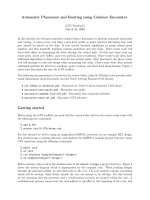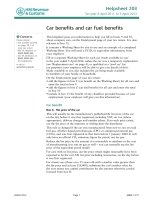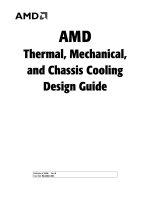Car Servicing and Repairs Mystery shopping research docx
Bạn đang xem bản rút gọn của tài liệu. Xem và tải ngay bản đầy đủ của tài liệu tại đây (362.34 KB, 129 trang )
Car Servicing and Repairs
Mystery shopping research
Contents Page
Executive Summary 2
Introduction 5
Objective of the research 7
Research Methodology 8
Results – 17
Garage Servicing
Results – 30
Fast Fit Outlets
Appendix I
Tables of Results 33
Appendix II
Questionnaires 105
Appendix III
Case Studies 125
Car Servicing and Repairs:
Mystery shopping research
2
Executive Summary
This report presents the findings of a nationwide survey of the car servicing and repair
market in the UK. The survey was commissioned by the Consumer and Competition
Policy Directorate of the Department of Trade and Industry, with the help of a
steering group with representatives from OFT, NCC, TSI, LACORS and VI, and was
undertaken by ITS Research and Testing Centre, formerly Consumers’ Association
Research & Testing Centre, between March and June 2002.
The project consisted of a mystery shopping exercise designed to obtain information
on the quality of service to the consumer in the car servicing and repair sector.
A range of garages was included in the research – car manufacturer’s franchises
(franchise dealers), of which 119 garages were visited, independent garages, of which
88 were visited and fast fit Centres, of which 58 were visited. The respective totals
reflected the approximate value of the market share for each business type.
The research was two fold – garage servicing among the franchise dealers and
independent garages, and brake and tyre checks among the fast fit centres.
The project was designed with a sufficient sample to give statistically robust data that
in turn could provide a reasonable representation of the sector as a whole. It includes
a representative national cross section of businesses within the sector, including
different sizes and types of business. It distinguishes between trade association
members and non-members.
Trading Standards’ recommended independent mechanics were used to inspect
cars before and after servicing. During the pre-service inspection the mechanics noted
any faults found on the car that should be rectified or reported, marked any
components that should be changed according to the manufacturer’s service
schedule, and introduced a number of non-safety critical faults to the car.
3
Findings - Garage Servicing
● Only 5% of garages surveyed were rated very good, indicating they had carried
out a thorough service, according to the manufacturer’s service schedule,
rectified all the introduced faults and other defects found prior to service.
● 51% were rated either poor or very poor. A poor rating indicated that the garage
had omitted more than two minor items, or the vehicle had a minor safety defect
that the garage had failed to rectify or report. ‘Very poor’ indicated that the garage
had missed one or more serious safety related faults, or a major service item that
should have been carried out or a part replaced had not been conducted.
● There was no significant difference in overall ratings between the types of
garage – 53% of independent garages and 50% of franchise dealers were rated
either poor or very poor with 6% of independents and 4% of dealers being
rated as very good.
● There was no significant difference in overall ratings between trade association
members and non-members.
● There were differences, between regions, with the North of England, Wales and
Northern Ireland performing worse than the other regions.
Additional notable points from the research are as follows:
● Overall, 17% of garages carried out unnecessary work. This was particularly so
in London and the South where 28% of garages carried out unnecessary work.
● Overall, 40% of garages missed or did not replace at least one item on the
service schedule. This was particularly so for female car owners – 58%.
● Overall, 86% of garages missed at least one of the introduced faults.
17% missed all four introduced faults.
● 43% of garages did not provide customers with an accurate quote prior to
the service.
● 71% of garages did not show the customer the original parts that had been
replaced.
● 8% of garages carried out work that had not been agreed with the customer
prior to the work being undertaken. This percentage was higher among
independent garages – 12%.
● Services were most expensive in London and the South and cheapest in Scotland.
4
Findings - Fast Fit Centres
● 28% of the Fast Fit Centres were rated poor or very poor for overall quality
of work, with only 2 of our sample (3%) carrying out a thorough check and
rectifying both the introduced faults.
● There were no significant differences in overall ratings between the different
chains in our sample, including across the regions.
Additional notable points from the research are as follows:
● 33% of the outlets recommended replacing brake components, of these
32% were unjustified (approximately 10% of the total).
● Almost 30% of the outlets recommended replacing tyres, of these 35%
were unjustified (just over 10% of the total).
● 95% of outlets missed at least one of the two faults introduced. 67%
missed both.
● 83% of outlets missed the deflated spare tyre.
Taking the overall service rating to be the most important sample characteristic, we
are confident, at the 95% significance level, that the mean overall service ratings for
garages/fast fit centres in the UK will differ by no more than 0.5 (i.e. half a point on
a 5-point scale) from the sample results.
5
Introduction
This report presents the findings of a nationwide survey of the car servicing and repair
market in the UK. The survey was commissioned by the Consumer Affairs Directorate
of the Department of Trade and Industry and was undertaken by the ITS Research and
Testing Centre, formerly Consumers’ Association Research & Testing Centre.
The project consisted of a mystery shopping exercise designed to obtain information
on the quality of service to the consumer in the car servicing and repair sector. It was
the result of a recommendation in September 2001 by the DTI Task Force on Car
Servicing and Repair that ‘further work should be undertaken to improve the quality
of evidence on consumer detriment in the sector’.
Consumer detriment was defined to include:
● being charged for work not carried out
● work being carried out, or recommended, unnecessarily
● failure to carry out safety checks to detect simple faults (eg tyres, brakes
or lights)
● work being carried out without approval
● being charged more than they might have expected to pay, based on the
information provided prior to the work being carried out
● not being provided with written quotes/estimates and invoices
● poor level of customer care
● non compliance with stated standards to which the service provider claims
to adhere.
The research was designed, to address these issues.
6
The research was divided into two areas:
● garage servicing – covering the top 10 car manufacturer’s franchise garages and
a range of independent garages.
● Fast Fit Centres – covering the top 5 fast fit outlets
The survey consisted of the following phases:
● Market picture
● Recruitment of Which? members and other car owners to take part in
the research
● Selection and identification of specific garages
● Recruitment of Trading Standards recommended engineers (inspectors)
● Pre-inspection of the cars against manufacturer’s service schedules before
servicing
● Introduction of non-safety critical faults (4 for garage servicing, 2 for Fast Fits)
● Post-inspection of the cars ie after servicing
● Completion of car owner and inspection questionnaires
● Statistical analysis of the results
● Overall co-ordination by ITS-RTC
7
Objective
The overall objective of this research was to provide up to date information on the
performance in the sector.
Specific types of evidence tested for were:
● Any practices causing detriment to consumers according to types of business
and across the regions.
● Any differences between male and female consumers.
● Degree of compliance with the motor industry codes of practice.
The project was to be designed to be representative of the sector as a whole.
8
Research Methodology
Cars/Car Owners
The Consumers’ Association maintains a large database of members with details of car
ownership. This was used to recruit the volunteers required for this survey and
included up to date information on approximately 34,000 cars.
The members’ cars selected for the situation research exercise were between four
and six years old and had covered between 25,000 and 75,000 miles.
The members were charged with taking their own cars to the garages for the service.
They were instrumental in data collection, gathering information concerning the
quality of service received. The information was collected using the ‘members
questionnaire’, a copy of which is included in Appendix II.
Towards the end of the exercise it was found necessary to use a small number of cars
belonging to members of staff of ITS-RTC and others, in order to fill gaps. Cars from
eleven members of staff and 7 associates of members of staff were used. These
individuals were fully briefed in the same way as the CA members.
9
Inspectors
Trading Standards’ independent approved mechanics were used to inspect cars before
and after servicing. Help in identifying appropriate engineers around the country was
provided by Local Authorities Coordinators of Regulatory Services (LACORS), who asked
local authorities to identify trusted individuals, with a proven track record in the field of
anonymous vehicle inspections - most were recruited in this way. Of the eleven inspectors
recruited, two were sourced by ITS RTC directly. The qualifications of these inspectors were
in line with the LACORS recommended engineers and both had a proven track record of
working as expert vehicle industry consultants. 6% of the inspections were performed by
ITS-RTC car testing staff. These members of staff have many years experience of vehicle
related projects, including car testing and garage servicing projects for Which? magazine.
The motor engineers recruited for the exercise were trained to perform the inspections
during briefing sessions that were either held at ITS-RTC or by visiting the engineers at
their normal place of work. This enabled a consistent approach among the engineers
according to standard ITS and Consumers’ Association testing procedures.
The engineers were contacted on a week by week basis with feedback concerning the
quality and consistency of their work, maintaining standards throughout the duration
of the project.
10
Faults
The inspectors noted any faults found on the cars, which should be rectified or
reported during the service or check.
Introduced faults
A few faults were introduced to the cars by the inspectors. The faults were selected on
the basis that they did not result in the car becoming illegal when driven, but were of
a type that should have been detected and corrected by the garages as part of a
manufacturers’ recommended service schedule or during a routine check at a fast fit.
Garage Servicing faults: blown reversing lamp(s)
deflated spare tyre
100mm longitudinal split in front passenger wiper
blade missing tyre valve dust cap
Fast Fit faults: deflated spare tyre
missing tyre valve dust cap
Selected components marked
The inspectors marked the components that should be changed according to the
manufacturer’s service schedule to reveal whether the garage had adjusted or
replaced components as appropriate.
Garages
In order to cover a significant proportion of the UK garage servicing market within
the four-month time frame for this project, approximately 270 garages across the
UK (England, Wales, Scotland and Northern Ireland) were targeted– representing
approximately one percent of the total number of garages. To assist in the
implementation of the survey the UK was divided up into regions. These regions
were arbitrary and bear no relationship to the Standard regions.
11
Sampling
The survey was intended to cover three different business types within the garage
servicing and repair sector and cover both members and non-members of the main
motor industry trade associations:
● Car Manufacturer Franchises (Franchise Dealers)
● Independent Garages
● Fast Fit Outlets
There are an estimated 26,000 outlets in the UK offering car servicing and repair services;
over 6000 franchised dealers, 15,000 independents and almost 4000 fast fit outlets.
The relative proportion of the different garage type samples was chosen to reflect as far
as practicable the market share by value of each type, given the need also to achieve a
representative geographical spread. Although there are more independent outlets than
franchises, in terms of value of the repair and servicing market franchise dealers account
for approximately half the total market.
The table below gives data on the breakdown of the car servicing market as detailed
in the Mintel Market Intelligence report dated February 2002, Car Servicing/MOT.
Type of outlet
Franchise
Independent
Fast Fit
25%
60%
15%
51%
29%
20%
Mintel estimates
by no. of outlets
Project sample
45%
33%
22%
Mintel estimates
by value
12
Franchise Dealers
It was agreed to cover the top 10 franchise dealers in the UK. These cover 72%
of the total market for car sales:
● Citroen ● Renault
● Fiat ● Rover
● Ford ● Toyota
● Nissan ● Vauxhall
● Peugeot ● Volkswagen
Selections from each were spread as evenly as practicable across the regions.
Independent Garages
Garages were selected at random from the Yellow Pages to correspond with the
location of Which? members whose cars were being used. 7 or 8 independent
garages were selected in each region to reflect the approximate proportion of the
dealership tested.
Yellow Pages was selected as it has nationwide coverage and it was considered that
most independent garages would ensure they were represented in the directory since
it is distributed to every house in the country and is available on the Internet.
Fast Fit Outlets
Fast Fit centres also represent a significant proportion of the market for garage
servicing and repairs. It was decided to assess the top five chains and the following
were selected on the basis of number of outlets. Locations were selected to provide
national coverage and as even a spread across the five chains as practicable.
Fast Fit chain No. of Outlets
● Kwik-Fit 640
● Hi Q 564
● ATS Euromaster 555
● National Tyres and Autocare 545
● Rapid Fit 300
13
Selection and Identification of Specific Garages
All of the garages were selected at random using the Internet. The franchise
dealership and Fast Fit Centres could be selected by using the web sites set up by
the car manufacturers or fast fit chain – most of which had excellent dealer or outlet
locator sections. The independent garages were selected using the Internet Yellow
Pages (Yell.com) – this also enabled a list of garages to be identified rapidly.
When selecting the garages, it was necessary to make a preliminary anonymous
phone call to enable ITSRTC to establish that the garage was still trading, was trading
under the required franchise, and was a suitable garage for the shopper, both in terms
of geographic location and ability to deal with their specific make and model of car.
Information about requirements for booking a car in and trade association membership
could also be recorded during the telephone call.
Inspections
The cars were inspected by the motor engineers, both before and after the garage
service, and the condition compared against the appropriate manufacturers’ service
schedule taken from Glass’s ICME Service Schedules 2002. The results were recorded
using an "inspectors questionnaire", a copy of which is included in Appendix II. The
inspectors travelled to and from the members’ homes or place of work in order to
carry out the pre and post service inspections, to introduce faults to the car and, on
completion of the service, to correct any introduced faults missed by the garage.
14
Rating System
Garage Servicing
The inspectors rated the quality of service overall using the following rating scale.
Ratings took into account the following:
– whether the garage had carried out all items on the relevant service schedule,
– whether the introduced faults had been rectified or advised,
– whether additional faults found on the car had been rectified or advised,
– whether any unnecessary work had been carried out,
– whether work had been carried out satisfactorily.
The ratings were:
5 (very good) – All items have been attended to, or advised upon
(i.e. all items on the service schedule, all introduced faults,
where relevant, and other noted faults)
4 (good) – Only one minor item has been overlooked
3 (average) – Two minor items have been overlooked
2 (poor) – More than two minor items have been omitted, or the
vehicle has a minor safety defect
1 (very poor) – One or more serious safety related faults were missed,
or a major service item that should have been carried out
or replaced has not been conducted.
The cost of the service was not included in the rating system. The primary consideration
was how the service had been carried out to the manufacturer’s service schedule and
whether the faults on the car had been addressed.
15
Examples of Defects/Faults:
Minor Items
– Fluid level low (except brake fluid)
– Brake pad thickness less than 3mm
– Reversing light not working
Minor Safety defect
– Brake fluid on min level
– Light not working (excluding reversing light)
– Tyre under inflated by 10 to 20% of recommended setting
(approx. 0.4 bar/6psi to 0.8bar/12psi)
– Tyre over inflated by more than 0.5bar/7psi
– Poor wiper clearance/split wiper blades
Serious Safety defect
– Brake fluid level below min level
– Tyre seriously under inflated or split/damaged such that failure is likely
to occur
– Tyre tread below legal limit
– Both side/stop/head lights not working
16
Fast Fits
The inspectors rated the quality of service at Fast Fit Centres overall using the
following rating scale:
5 – very good advice – accurate indication of component wear, both
faults rectified
4 – good advice – reasonably accurate indication of component wear,
missed a minor fault
3 – satisfactory advice – reasonably accurate indication of component wear,
missed several minor faults
2 – poor advice – recommended replacement of serviceable components
if borderline
1 – very poor advice – recommended replacement of serviceable components,
if only partly worn
Co-ordination by ITS-RTC
In order to ensure a consistent approach throughout the survey, it was necessary to
maintain close control over the work being conducted in the field. This duty was
performed by ITS-RTC test engineers, each with between 10 and 20 years experience
of appraising and testing cars, for both mystery shopping type exercises and for car
performance tests.
ITS-RTC testing experts trained the inspectors to carry out the inspection work, and
checked the quality of inspectors work, providing feedback throughout the exercise.
ITS-RTC co-ordinated communications between the inspectors and the Consumers’
Association members across the UK.
ITS-RTC established garage membership of trade associations by checking invoices
and telephoning individual garages.
ITS-RTC also co-ordinated the payment of the inspectors and reimbursement of
garage service and other costs to Consumers’ Association members, located suitable
members for use in the situation research and co-ordinated the collection of
questionnaires and the production of a results spreadsheet.
ITS-RTC staff performed all of the project management involved in conducting the
situation research exercise.
17
Results –
Garage Servicing
Completed questionnaires were received for 207 car services. 119 of these services
were carried out by franchised garages and 88 services were carried out by
independent garages.
The number of garages in the sample by type (i.e. independent or dealer) and region
are shown in Table 1.1 in Appendix I.
The 119 franchised garages included between 10 and 13 garages of each of the
ten main car manufacturers. These were evenly distributed by region for most car
manufacturers. It was not possible to find a Fiat owner willing to take part in the
survey who lived in Wales or N. Ireland. For all other makes of car at least one car of
each make was serviced by a franchised garage in each of the five grouped regions.
Two-thirds of the 207 cars were taken to the garage by a male and one-third by a
female. Independent garages and franchised garages in total have the same
breakdown by sex but the breakdown by sex is variable for the ten dealers.
The independent and franchised garages have similar breakdowns by age of car,
size of car and by mileage.
18
Overall Quality of Service
Results from 119 franchised garages are included in this research (about 1.8% of all
franchised garages in the UK). We can say with 95% confidence that the mean overall
service rating for all 6500 franchised garages in the UK would be within 0.37 of the
mean overall service rating calculated using the results of the franchised garages in
the survey (i.e. a 95% confidence interval for the true population mean is
(2.39,3.13)).
Results from 88 independent garages are included in this research (about 0.5% of all
independent garages in the UK). We can say with 95% confidence that the mean
overall service rating for all 16000 independent garages in the UK would be within
0.46 of the mean overall service rating calculated using the results of the independent
garages in the survey (i.e. a 95% confidence interval for the true population mean is
(2.23,3.15)).
Combining the results for all garages gives us 207 garages (about 0.9% of all garages
in the UK). We can say with 95% confidence that the mean overall service rating for
all 22500 garages in the UK would be within 0.3 of the mean overall service rating
calculated using the results of the garages in the survey (i.e. a 95% confidence
interval for the true population mean is (2.20,3.26)).
106 garages (51%) were given a rating of 1 or 2 – very poor or poor. 10 garages (5%)
were rated 5 – the top rating, of these 5 were dealers and 5 independents. The
unweighted overall mean rating is 2.73.
There were no differences in the mean ratings by type of garage or by dealership.
22%
44%
5%
22%
7%
Overall Service rating
Ratings were based on the following rating scale:
All items have been attended to, or advised upon
Only one minor item has been overlooked
Two minor items have been overlooked
More than two minor items have been omitted,
or the vehicle has a minor safety defect
One or more serious safety related faults were missed,
or a major service item that should have been carried
out or a part replaced has not been done
1
2
3
4
5
19
The mean ratings by region were significantly different – the North of England, Wales
and Northern Ireland were rated 2 and the other three regions (Scotland, Midland
and the East, London and the South) were rated 3.
The mean rating for males was 2.8 and the mean rating for females was 2.6.
12%
2%
15%
24%
47%
13%
13%
58%
5%
11%
0%
3%
37%
23%
37%
6%
6%
28%
28%
32%
8%
8%
15%
20%
49%
North England – Service rating
Wales/N Ireland – Service rating
Scotland – Service rating
London/South – Service rating
Midlands/East – Service rating
20
Examples of services rated 1 (very poor)
Franchise dealer in Wales – 72,000 mile service carried out, these were the results of
the post-service inspection:
● The wrong air filter was fitted – this was approximately 6cm too short for the
application. As a result of which all air entering the filter box would pass over
the filter directly into the inlet manifold. This could cause serious internal wear.
● The coolant and power assisted steering fluid remained low. Also the coolant
header tank was left empty. There was therefore the real risk that the car could
overheat.
● Left side wing repeater was left inoperative and was not reported.
● Right side front side light was left inoperative and was not reported.
● Spare tyre pressure remained low and was not reported.
● Reversing lights were still inoperative and were not reported.
● The fuel filter was not changed.
● The right side and rear wipers were replaced unnecessarily.
● The missing mounting bush from the air filter box and the missing nut from the
exhaust manifold were not replaced or reported.
Independent garage in the North West – 36,000 mile service carried out. These were
the results of the post-service inspection:
● Low depth of tread on all running tyres (near legal limit), nail in left side rear
and piece of plastic in right side rear not reported.
● Left side front wiper not replaced or reported.
● Reversing light still inoperative and not reported.
● Spare pressure remains low and was not reported.
● Brake fluid not replaced.
● Fuel filter not replaced.
● Left side number plate light still inoperative.
21
● Rear washer jet still aimed too high.
● No fault found with knocking noise from underside – suggested just wear and
tear – (fault appears to be loose baffle in exhaust front box).
For more examples of both very poor and very good services please see Appendix III.
Being charged for work not carried out
● 40% of garages missed an item on the service schedule.
● Independent garages were slightly more likely than dealers to miss something
(44% compared to 36%).
● Garages in Scotland were least likely to miss something (17%).
● Garages were more likely to miss something if the car owner was a female
(58% compared to 40% for males).
● 56% of garages that missed something missed only one item. 18% missed
two items, 16% missed three items and 11% missed four or more items.
% garages that missed items on service schedule
60
53%
50
40
30
20
10
0
Mid & E North W & NI UK Lon & S Scot
%
46%
45%
40%
36%
17%
22
Unnecessary Work
● 17% of garages carried out work that was considered to be unnecessary by
our inspectors.
●
Independent garages and dealers were equally as likely to carry out unnecessary
work.
● There was no difference between female and male car owners.
● Garages in London and the South were much more likely to carry out
unnecessary work (28% compared to 14% for the other regions).
● 72% of the garages that carried out unnecessary work carried out one item
and a quarter carried out two items.
Failure to carry out checks to detect simple faults
Introduced faults
● 14% of garages rectified or advised on all four introduced faults.
17% of garages missed all four faults.
● Dealers rectified slightly more introduced faults than the independent garages.
There were differences across the regions in terms of number of faults rectified, but
these differences are not statistically significant.
% garages who carried out unnecessary work
28%
30
20
10
5
0
Lon & S UK Scot W & NI North Mid & E
%
17% 17%
16%
15%
8%
23
Split in front left wiper:
● 60% of garages rectified this fault. Another 12% advised the customer of the fault.
Over a quarter of garages did not rectify or advise the customer of this fault.
● Almost a third of independent garages missed this fault compared to just under
a quarter of dealers.
● Half the garages in Wales and Northern Ireland missed this fault compared to only
14% of garages in Scotland.
Low pressure in spare tyre:
● 46% of garages rectified or advised on the condition of the spare tyre.
● Dealers were slightly more likely to rectify the fault (50% compared to 41% of
independents).
● 61% of garages in the North of England rectified the fault compared with
about a third of garages in Scotland.
No. of rectified faults
Type of garage by no of rectified faults
Independent
Dealers
30
25
20
15
10
5
0
01 234
%
24
Reversing light blown:
● 55% of garages rectified or advised on this fault.
● Dealers were more likely than independents to do so (61% compared to 48%).
● Nearly 70% of garages in Scotland spotted the fault but only 42% of garages in
Wales and Northern Ireland did so.
Missing dust cap:
● Over two-thirds of garages missed this fault.
● Garages in Scotland were most likely to miss this fault (80%) whereas just over
half of garages in the Midlands and East missed this fault.
Introduced faults: Mean number rectified
2.5
2.0
1.5
1.0
0.5
0.0
North Lon & S Mid & E UK Scot
%
W & NI
2.20
2.08
2.08
1.93
1.66
1.53
Introduced faults: % rectified 0/4 & 4/4
Rectified 0/4
Rectified 4/4
25
20
15
10
5
0
Lon & S Mid & E North UK Scot
%
W & NI
21%
19%
13%
18%
17%
14%
17%
6%
24%
5%
10%
17%









